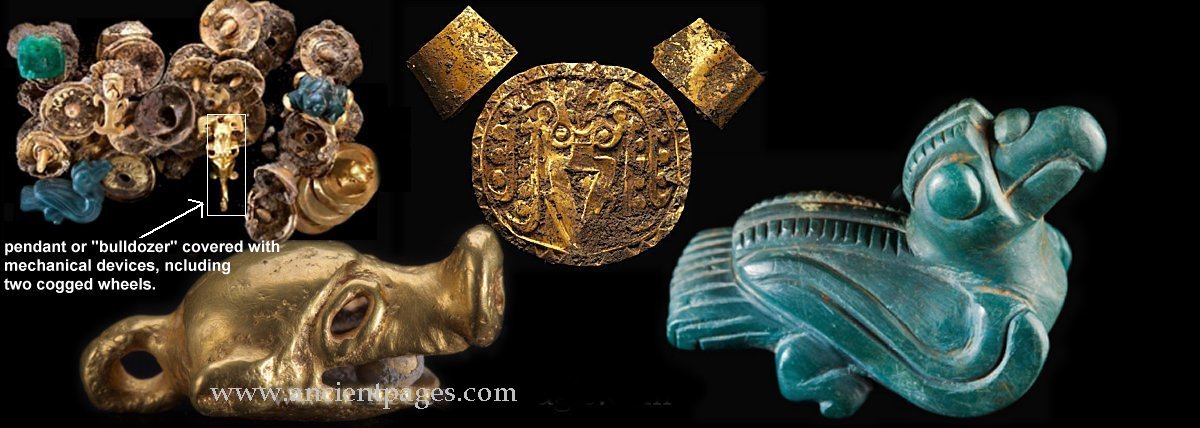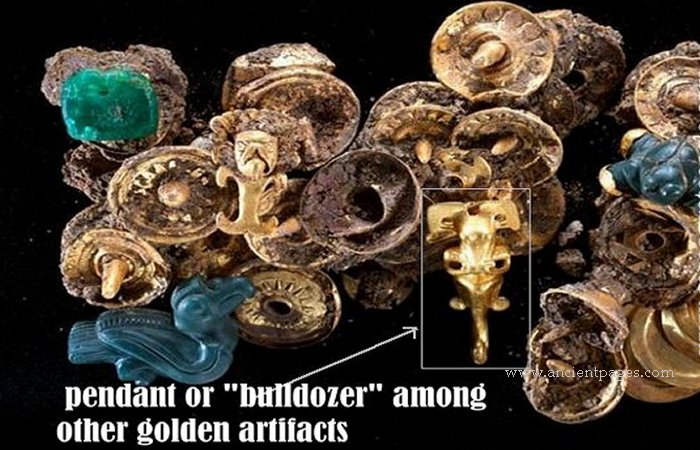Mysterious Golden Lords Of Panama
A. Sutherland - AncientPages.com- Our fascination with golden objects dates back to ancient times but gold has often very dark and gruesome history accompanied with lost life of innocent people.
Not long ago, numerous artifacts of gold and precious stones, indicating the existence of a previously unknown civilization, were discovered in the town of El Caño in Panama.
This amazing find is considered one of the most significant discoveries of the last century and similar to that of the Sitio Conte site, also in central Panama, located only two miles (three kilometers) from Sitio Conte.
The discovery proves the golden-chiefs culture, which can be traced from about A.D. 250 to the 16th century, when Spanish conquerors arrived on the scene.
According to early Spanish accounts, only paramount chiefs had the right to wear certain types of gold ornaments, such as the breastplate.
These people had supernatural power as well as political authority.
Early Spanish sources indicate that gold plaques and other gold adornments were worn to war and to the grave.
According to researchers, El Caño people are "best regarded as a separate and distinct (though unnamed) culture that flourished in central Panama.
However, in ancient tombs hidden in the jungle of Panama there is much more than only gold.
This archaeological site, El Caño, contains three pre-Columbian mounds that date back between AD 500 and 1200. The larger of the two mounds revealed five skeletons in the same position as when they were unearthed at 4m below the surface.
One is believed to be the grave of a chieftain, as it contained a number of gold and emerald objects. A small museum displaying pieces of pottery, arrowheads, and carved stones found at the site was under renovation at the time of research.
Also here are rows of stone pedestals, which are the remains of the so-called Temple of a Thousand Idols, removed by an American adventurer in the 1920s and sent to a museum in New York.
A few years ago, archaeologist Julia Mayo of the Smithsonian Tropical Research Institute began to re- investigate the area covered by ancient stone monoliths and mysterious sculptures, and popular among treasure hunters especially in the early 20th century.
During excavations in early 2011, archaeologists discovered the burial of a senior man. The grave had several levels and was closed with a wooden roof. Together with this man were also buried another 25 people whose bodies were stacked neatly.
Researchers found children's golden outfit, perhaps intended for the son of the ruler, small gold plates, bracelets, earrings and a necklace of semiprecious stones. At the bottom of the grave, scientists have found the remains of 15 people whose bodies serve as a base.
These people could be the captured soldiers or slaves who were sacrificed or committed suicide. As reported by archaeologists, in the vicinity of the bodies, there was found a vessel filled poisonous fish bones Guentheridia Formosa. Additional interesting detail were the remains of people covered with" ceramic plates, the purpose of which is not entirely clear," reported National Geographic.
There is an ancient myth found among the Chibcha, also called Muisca, and their modern descendants, the Cueva Indians, in the eastern part of Panama. According to the myth, the Chibcha had extraordinary skills that are unknown today. It also had extraordinary powers of working gold forming it to gold helmets, beautiful filigree gold chains and other precious ornaments representing men with animal heads, bats, frogs, spiders and eagles.
These artifacts remain a fascinating legacy of the Cueva Indians.
Updated on March 4, 2024
Written by – A. Sutherland AncientPages.com Staff Writer
Copyright © AncientPages.com All rights reserved. This material may not be published, broadcast, rewritten or redistributed in whole or part without the express written permission of AncientPages.com
Expand for referencesReferences:
McCarthy C., Fallon S. Lonely Planet Panama
[/expand]More From Ancient Pages
-
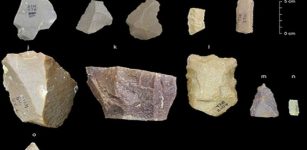 Ancient Stone Tools Found In India Suggest Humans Ancestors May Have Left Africa Much Earlier Than Previously Thought
Archaeology | Feb 5, 2018
Ancient Stone Tools Found In India Suggest Humans Ancestors May Have Left Africa Much Earlier Than Previously Thought
Archaeology | Feb 5, 2018 -
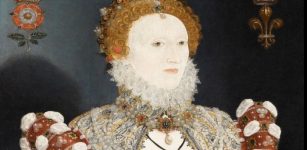 Queen Elizabeth I Was Identified As Author Of Tacitus’s Annales Translation
News | Dec 1, 2019
Queen Elizabeth I Was Identified As Author Of Tacitus’s Annales Translation
News | Dec 1, 2019 -
 Underwater Archaeologists Explore The Secrets Of Loch Achtily Crannog – Will They Find A Rare Medieval Settlement?
Archaeology | Mar 26, 2025
Underwater Archaeologists Explore The Secrets Of Loch Achtily Crannog – Will They Find A Rare Medieval Settlement?
Archaeology | Mar 26, 2025 -
 Mysterious Books With Dangerous Secret Knowledge Deliberately Hidden From Public View
Featured Stories | Jan 8, 2024
Mysterious Books With Dangerous Secret Knowledge Deliberately Hidden From Public View
Featured Stories | Jan 8, 2024 -
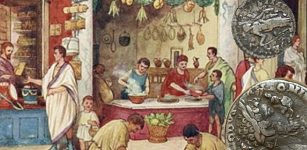 Thousands Of Roman Coins Found Across Europe Are Fake – Archaeologists Say
Archaeology | Jul 9, 2019
Thousands Of Roman Coins Found Across Europe Are Fake – Archaeologists Say
Archaeology | Jul 9, 2019 -
 Interesting Relief Sculpture Of Pharaoh Hatshepsut Found At Swansea University
Archaeology | Mar 27, 2018
Interesting Relief Sculpture Of Pharaoh Hatshepsut Found At Swansea University
Archaeology | Mar 27, 2018 -
 Rio Tinto Bosses Quit Over Destruction Of One Of The Earliest Aboriginal Sites
News | Sep 12, 2020
Rio Tinto Bosses Quit Over Destruction Of One Of The Earliest Aboriginal Sites
News | Sep 12, 2020 -
 Ancient Mesoamerican Board Games ‘Patollis’ Discovered In Mexico
Archaeology | Sep 9, 2024
Ancient Mesoamerican Board Games ‘Patollis’ Discovered In Mexico
Archaeology | Sep 9, 2024 -
 Fossil Bones From The Largest Penguin That Ever Lived Unearthed In New Zealand
Fossils | Feb 10, 2023
Fossil Bones From The Largest Penguin That Ever Lived Unearthed In New Zealand
Fossils | Feb 10, 2023 -
 America’s Mysterious Pedro Mountain Mummy And The Hidden Race Of Little People
Featured Stories | Jul 3, 2014
America’s Mysterious Pedro Mountain Mummy And The Hidden Race Of Little People
Featured Stories | Jul 3, 2014 -
 On This Day In History: Viking Forces Laid Siege To Paris – On Nov 25, 885
News | Nov 25, 2016
On This Day In History: Viking Forces Laid Siege To Paris – On Nov 25, 885
News | Nov 25, 2016 -
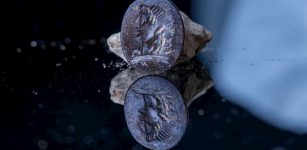 How Did A Rare 2,000-Year-Old Gem Seal Depicting God Apollo End Up In The City Of David?
Archaeology | Nov 5, 2020
How Did A Rare 2,000-Year-Old Gem Seal Depicting God Apollo End Up In The City Of David?
Archaeology | Nov 5, 2020 -
 Surprising Evidence Of 12,000-Year-Old Unknown Advanced Secret Knowledge Held By Elite Individuals – The Article – Part 1
Ancient Mysteries | Feb 4, 2021
Surprising Evidence Of 12,000-Year-Old Unknown Advanced Secret Knowledge Held By Elite Individuals – The Article – Part 1
Ancient Mysteries | Feb 4, 2021 -
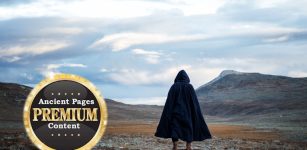 Mysterious Deaths In A Dangerous Valley May Be Related To Ancient Events
Ancient Mysteries | Mar 14, 2022
Mysterious Deaths In A Dangerous Valley May Be Related To Ancient Events
Ancient Mysteries | Mar 14, 2022 -
 Longest European Burial Mound Pre-Dating The Egyptian Pyramids Discovered In Czechia
Archaeology | Jun 24, 2024
Longest European Burial Mound Pre-Dating The Egyptian Pyramids Discovered In Czechia
Archaeology | Jun 24, 2024 -
 Ancient Secrets Of The Masters Of Mu – Myths And Legends Examined – Part 1
Ancient Mysteries | Aug 24, 2018
Ancient Secrets Of The Masters Of Mu – Myths And Legends Examined – Part 1
Ancient Mysteries | Aug 24, 2018 -
 Genghis Khan Has 16 Million Relatives – You Could Be One Of Them
Ancient History Facts | Feb 3, 2018
Genghis Khan Has 16 Million Relatives – You Could Be One Of Them
Ancient History Facts | Feb 3, 2018 -
 Very Rare Ancient Roman Horse Brooch Discovered In UK
Archaeology | Mar 7, 2020
Very Rare Ancient Roman Horse Brooch Discovered In UK
Archaeology | Mar 7, 2020 -
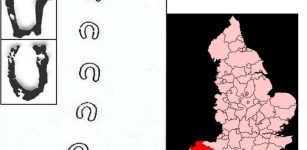 On This Day In History: ‘Devil’s Footprints’ Appeared In Devon, England – Feb 8/9, 1855
News | Feb 8, 2017
On This Day In History: ‘Devil’s Footprints’ Appeared In Devon, England – Feb 8/9, 1855
News | Feb 8, 2017 -
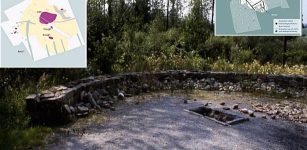 Burnt Mound Complex Dated To Bronze Age – Uncovered At Suffolk Site
Archaeology | Jun 19, 2023
Burnt Mound Complex Dated To Bronze Age – Uncovered At Suffolk Site
Archaeology | Jun 19, 2023


